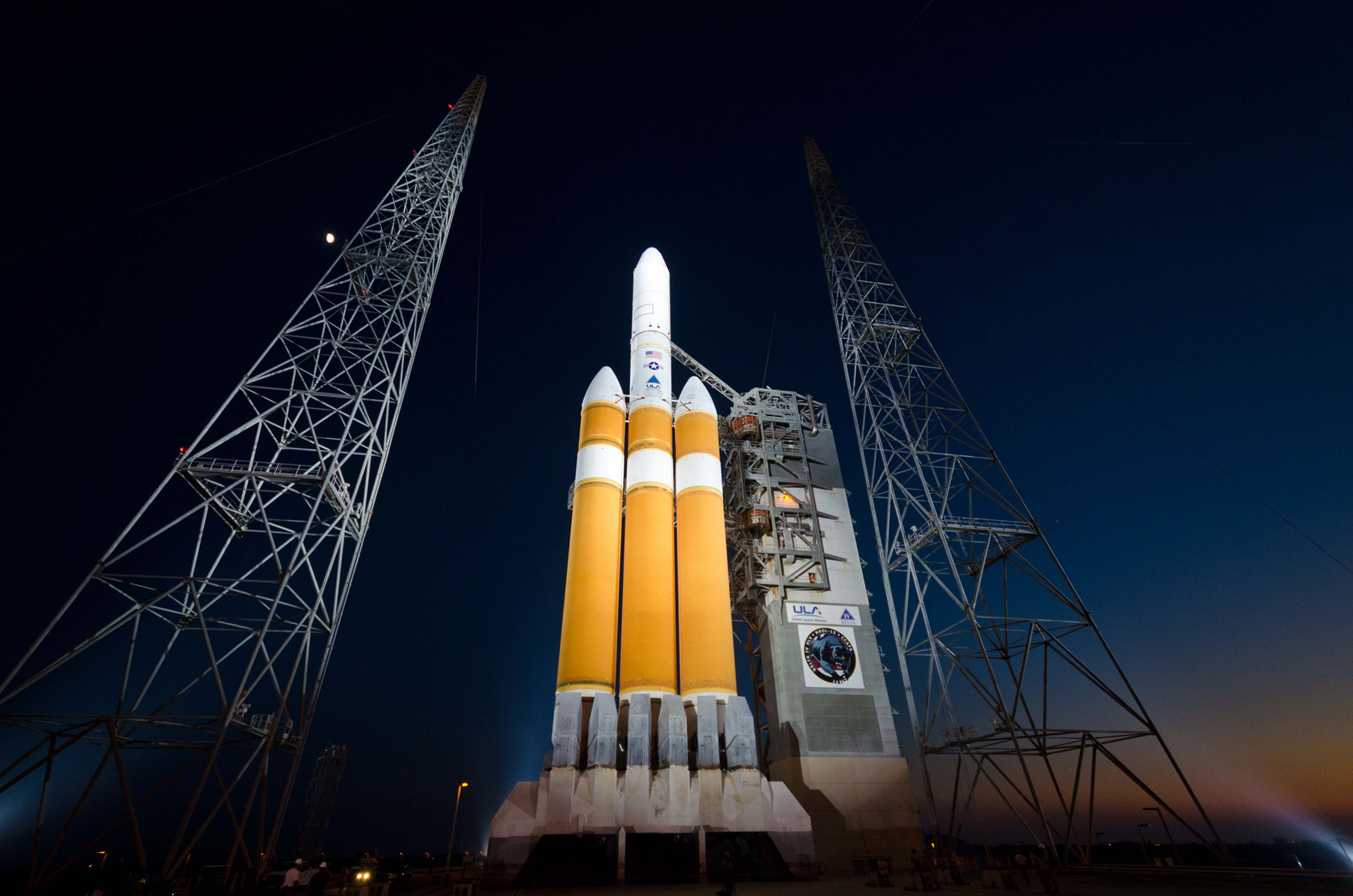A huge Delta IV Heavy rocket will launch a new US spy satellite overnight. Here's how to watch.
Update for Aug. 29 at 3:40 a.m. EDT: ULA scrubbed Thursday morning's launch attempt due to an issue with a ground pneumatics control system, and Saturday morning's attempt was aborted a few seconds before liftoff. It's unclear at the moment when the next launch opportunity will come.
CAPE CANAVERAL, Fla. — United Launch Alliance (ULA) is gearing up to launch its mightiest candle in the fleet of rockets: the Delta IV Heavy. The behemoth is set to blast off on Thursday (Aug. 27) at 2:12 a.m. EDT (0612 GMT), carrying with it a satellite for the National Reconnaissance Office, and you can watch all the fiery action live.
The eight-and-a-half-hour-long countdown will kick off tonight (Aug. 26) at 5:42 p.m. EDT (2142 GMT) and include two planned 15-minute holds. Launch coverage will begin about 20 minutes prior to liftoff, and you can watch the launch live here on Space.com or via ULA.
According to ULA, the mission's launch window opens at 1:50 a.m. EDT (0550 GMT) and extends to 6:25 a.m. EDT (1025 GMT), with the company targeting a liftoff of 2:12 a.m. EDT (0612 GMT). There may be other opportunities within the period, but officials have not yet disclosed those.
Related: Spy satellite NROL-71 soars on secret mission atop Delta IV Heavy rocket
Launching from Space Launch Complex 37 here at Cape Canaveral Air Force Station, the heavy-lifter is toting a classified payload for the National Reconnaissance Office (the U.S. government's spy satellite agency).
The mission, code-named NROL-44, marks the 12th flight of a Delta IV Heavy rocket since its debut in 2004, and is one of only five Delta rockets remaining as ULA plans to retire the launcher before rolling out its next-generation vehicle, the Vulcan Centaur. (ULA previously retired the Delta II rocket in 2018, and its Delta IV Medium in 2019.)
Breaking space news, the latest updates on rocket launches, skywatching events and more!
The weather forecast looks good for tomorrow's planned liftoff, with an 80% chance of favorable conditions and only minor concerns for cumulus cloud formation as a result of isolated showers moving onshore, according to the most recent forecast issued by the Air Force's 45th Weather Squadron, which monitors the weather for launches from Cape Canaveral.
Shortly before the launch countdown begins, the 330-foot-tall (100 meters) shroud encasing the rocket — called the Mobile Service Tower, or MST — will roll away from the colossal craft. Composed of three hydrogen-fueled first-stage common core boosters (which are strapped together) and a cryogenic second stage, the Delta IV Heavy stands 233 feet (71 m) tall and measures approximately 53 feet (16 m) wide.
Fueled by 465,000 gallons (1.76 million liters) of superchilled liquid hydrogen and liquid oxygen, the massive rocket generates more than 2 million pounds of thrust. It's currently the most powerful rocket in ULA's fleet.
Related: Delta IV Heavy: Powerful launch vehicle
Of the previous 11 Delta IV Heavy launches, seven carried NRO payloads. Some of the vehicle's other notable missions ferried NASA's Orion capsule on an uncrewed test flight and the agency's Parker Solar Probe on a mission to study the sun.
All five of the remaining Delta IV Heavy missions will launch NRO satellites. Three will launch from the Cape, including this one, and two will launch from California's Vandenberg Air Force Base.
Many NRO payloads are extremely heavy and bulky, akin to launching a school bus, and are designed to be installed on top of their rockets in a vertical configuration rather than a horizontal one. For that reason, military officials say that the Delta IV Heavy is the only launcher on the market today that can accommodate their needs.
SpaceX also has a heavy-lift vehicle — the Falcon Heavy — but it uses a horizontal technique to integrate its rockets and payloads. Additionally, the fairing (or nose cone) on the Delta IV Heavy is larger than the one on the Falcon Heavy, so the Delta can better accommodate the massive NRO satellites.
However, the Falcon Heavy rocket does have an advantage over the Delta, as it can lift heavier cargo into space at a reduced cost. In 2018, the Air Force awarded SpaceX a coveted contract worth $130 million to launch a military payload, which is less than half the estimated cost of a Delta IV Heavy mission.
When it comes online, the Vulcan Centaur will have the same vertical integration capability as the Delta; however, SpaceX plans to switch things up by offering vertical integration capabilities as well as an extended fairing for its Falcon Heavy rocket in the future, to make the launch system more competitive.
On Aug. 7, the Department of Defense announced that ULA and SpaceX will share launch duties for military launches through 2027. ULA was awarded 60% of the contracts, with SpaceX receiving the other 40%.
Follow Amy Thompson on Twitter @astrogingersnap. Follow us on Twitter @Spacedotcom or Facebook.

Amy Thompson is a Florida-based space and science journalist, who joined Space.com as a contributing writer in 2015. She's passionate about all things space and is a huge science and science-fiction geek. Star Wars is her favorite fandom, with that sassy little droid, R2D2 being her favorite. She studied science at the University of Florida, earning a degree in microbiology. Her work has also been published in Newsweek, VICE, Smithsonian, and many more. Now she chases rockets, writing about launches, commercial space, space station science, and everything in between.


